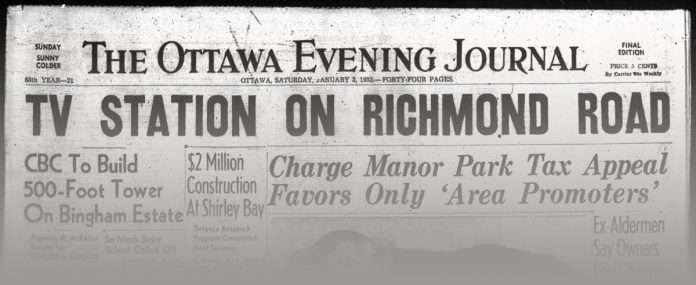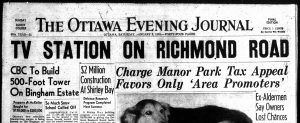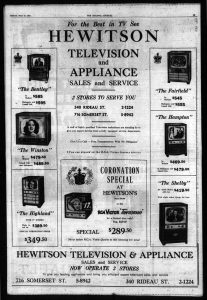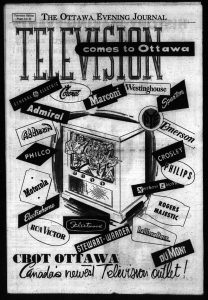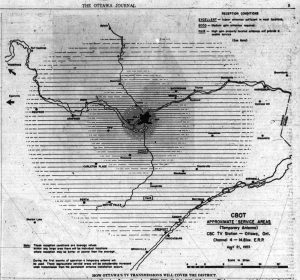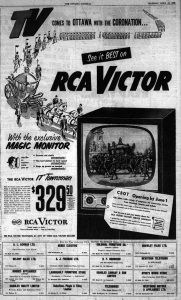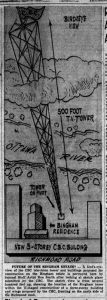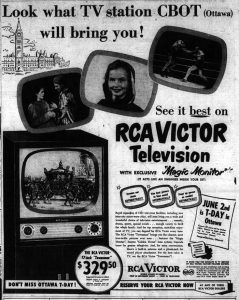By Dave Allston –
Television’s arrival in Ottawa in 1953 was no doubt one of the most memorable events for anyone who lived through that era. It had a significant influence on the social and economic habits of local families and it was here in Kitchissippi that television for Ottawa was born.
Until the fall of 1952, television was but a dream for almost all Canadians. A sweeping phenomenon in the United States for several years, only those who resided close to the border near larger American cities could pick up a signal. However, even obtaining a television set was a challenge because they were expensive and subject to import restrictions.
In 1950, CBC announced that they would be building Canada’s first television network, starting with stations in Montreal, Toronto, and Ottawa. CBC borrowed $8M from the federal government to purchase equipment, hire and train staff, construct the microwave network and build its first stations. This loan was to be repaid through advertising revenues and a 15% tax on the sale of all sets.
Critics warned of the dangers of television and referred to it as a “home invader.” Many worried that children would lose their desire to read or create their own fun, and perhaps even lose their ability to walk. NHL president, Clarence Campbell, considered television “the most terrible menace ever to come to the entertainment world,” citing its effect on attendance at sporting events.
Early TV buyers had just two options: the 17” or 21” model. Though larger screens were under development, one report noted “the larger the set, the farther away from it a viewer must sit. For this reason, most homes will not need a larger screen than is now available.”
Sets cost between $300 (which is about $2,900 in 2018 dollars) for a basic table model to $600 ($5,800) for a wood console. Combination TV-radio-gramophone units cost as much as $1,600 ($15,500).
There were only 19,053 TVs in Canada in 1951, 250,000 by 1953 and over one million by the end of 1956. The race was on to train servicemen, as absolutely no one in Canada had practical experience. Wise buyers demanded service guarantees from the dealer.
[Click images to enlarge.]
CBC officially hit the airwaves in Montreal and Toronto in September 1952. Ottawans desperate for TV could receive the Montreal channel (and later a Syracuse station) with the installation of a large rooftop antenna. Only the eventual Ottawa station could be received without an antenna, so the skyline of most Ottawa neighbourhoods in the mid-late 1950s was dotted with an unsightly array of rooftop ugliness.
1953 began with the announcement that CBC had purchased the McKellar-Bingham property on Richmond Road (at Windermere) and would be constructing horseshoe-shaped studios around the heritage building (which would be retained for offices), and a 500’ high transmission tower. CBC considered the west end the only viable option for the tower, due to Uplands and Rockliffe airports. Many residents, including Mayor Charlotte Whitton, were against the “desecration of one of the finest views of the district,” having recently preserved Maplelawn and fought against the construction of industrial warehouses along the water in Westboro.
The Mayor pushed River Street on the way to Lemieux Island (the elevation of which the CBC considered too low), while other options at Carleton Heights, Kingsmere, and the old Magee farm (Lincoln Fields) were dismissed.
Finally, on February 13, 1953, it was announced that the CBC had purchased 8.5 acres of land on Lanark Avenue north of Scott Street that had previously been set aside by the city for future housing development. Within days, building permits were issued and shovels were in the ground. A temporary 70’ tower was constructed to ensure the CBC could still meet their rushed goal of being on the air by Coronation Day in June.
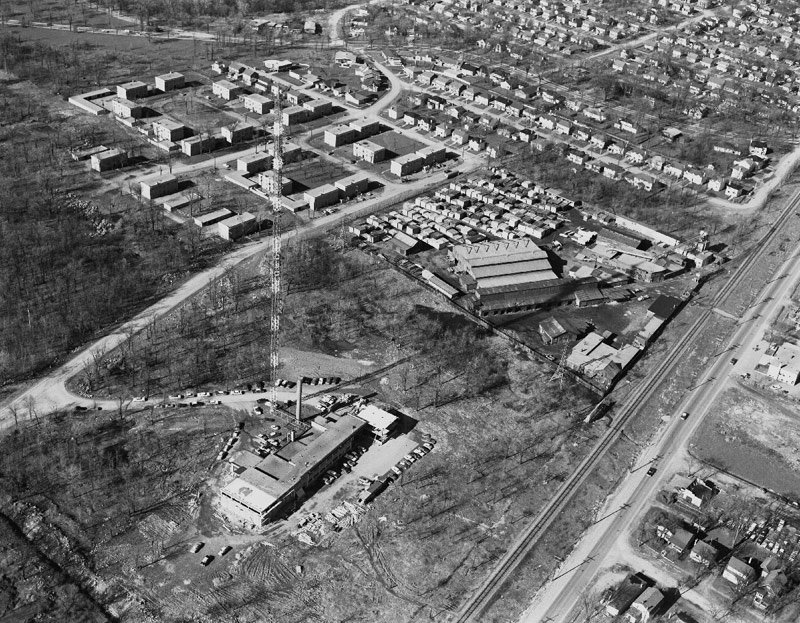
The arrival of TV was big news in Ottawa. On May 22, the Ottawa Journal ran a 32-page special edition for “T-Day” with dozens of TV ads and details on the development of TV and how it worked. Before May, one could hardly find a TV for sale in Ottawa; suddenly they were the hottest item in town.
On May 14, CBC’s 340-mile microwave relay system went into service, linking Montreal and Toronto, creating the first network TV broadcasts that viewers in both cities watched simultaneously. Ottawa was soon to join this network.
Ottawans were teased with the first test patterns transmitted from Lanark Avenue on May 13 and occasional test video soon after.
CBOT Channel 4 Ottawa began regular broadcasting at 6:45 p.m. on Monday, May 25, 1953. The first show was “Uncle Chichimus,” a puppet show for children. On June 2 – Coronation Day – CBC broadcast the events just hours after they happened. RAF Canberra jets delivered the films across the Atlantic to an awaiting CF-100 at Goose Bay, which delivered them to CBC Montreal. More than 100 Ottawa schools were provided TV sets for the day by the Radio-Television Manufacturers Association and citizens packed in front of store windows to share this milestone day.
At first, CBC only aired programs in the evenings from 5-11 p.m., plus special events – such as sports – on weekend afternoons. Mobile units relayed live sports to the transmitter, the first being the Ottawa Athletics-Montreal Royals baseball game on June 9. The Rough Riders were paid $5,000 per game to allow CBOT to televise three games in August.
The 492’ tower and production studio on Lanark Avenue were finally completed in early 1955. The tower was later moved to Camp Fortune in 1966, the same year CBC Ottawa switched to colour programming.
In June 1955, CBC obtained permission from the federal government to allow a second station in Ottawa (CBOFT), thus establishing both French and English stations. A third station came along in March 1961 when CJOH went on the air. Its initial studios were located in a building at the corner of Somerset and Bayswater, which is now home to the Ottawa Integrative Cancer Centre.
Technological advances eventually phased out the Lanark Avenue studio and when it closed in 2004 it truly marked the end of an incredible era in Kitchissippi.
Dave Allston is a local history buff and author of The Kitchissippi Museum. His family has lived in Kitchissippi for six generations. Do you have stories to share about the area? Memories of early TV? Send your email to stories@kitchissippi.com. To read more of Dave’s columns, click here.
